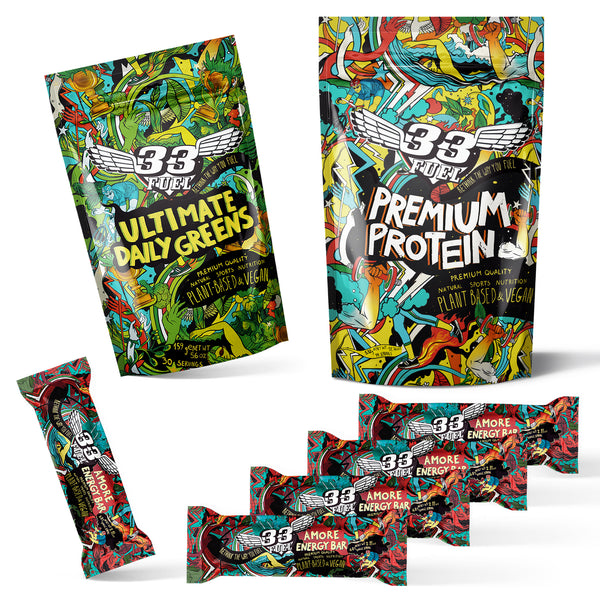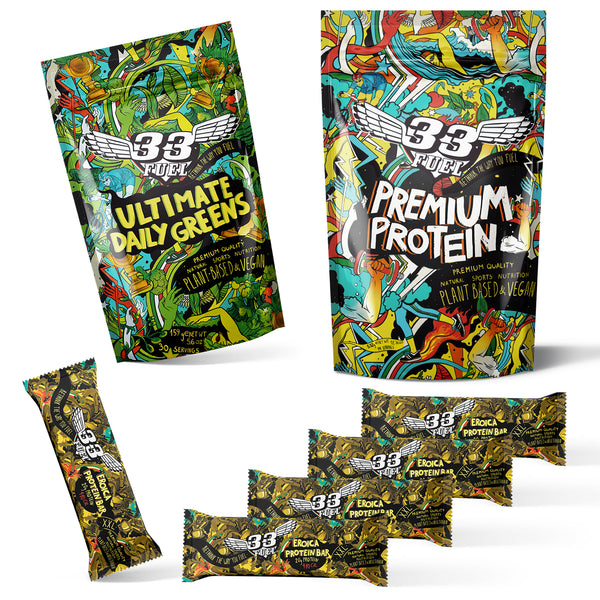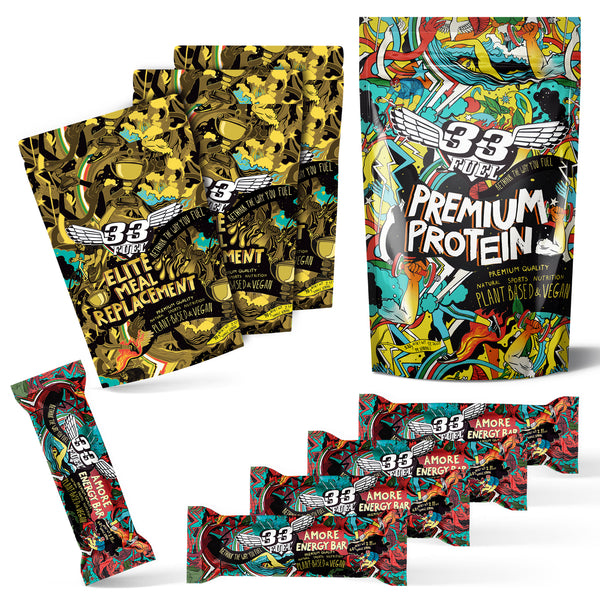How To Prevent Age-Related Muscle Loss

You might think age-related muscle loss isn’t something you need to worry about right now. But as you enter your late 30s and 40s, strength and lean muscle mass naturally declines. Here we share tips on how to prevent age-related muscle loss so you can maintain an active life into your 50s, 60s and beyond
What is sarcopenia?
Sarcopenia is the loss of skeletal muscle mass and function. As young as we may still feel when we hit 40, the truth is our bodies are in decline.
Prevent age-related muscle loss with award-winning sports nutrition
Best Sellers
Sarcopenia is predominantly caused by:
- Age-related hormone changes. Oestrogen, testosterone, DHEA, vitamin D and growth hormone all decline with age
- Decreased appetite. This is more applicable to elderly people and likely not many readers of this blog but it’s an important factor
- Decreased activity in the nerves which cause muscle contraction. This is heightened by inactivity. In short: use it or lose it. Inactive people can lose up to 5% of their muscle mass every decade.
Although we can’t fight age, there is plenty we can do to minimise the impact of sarcopenia. And let’s be honest, anyone reading this isn’t worried about becoming frail, unstable on their feet and worried about being able to rise from their chair anytime soon!
BUT, as many of us enter middle age, we’d be wise to heed these words from expert physiotherapist Gary Calabrese:
“Younger adulthood and middle age is when you want to get a jump on this [age-related muscle loss] to preserve muscle strength over time”
How to prevent age-related muscle loss: Strength training

It may not be your preferred training ground, but the benefits of one gym session per week as worth it
The single biggest thing you can do to reduce the decline in muscle mass as you age is to add resistance workouts to your training. You can do this both in the gym and outdoors but the key here is consistency.
Start now and keep doing it. Add one strength session per week this week and continue to do one session per week for a month. Then add a second. Just keep the consistency there. Once you’ve routinely completing one session per week, add another so you’re doing 2 x 30-minute sessions week in, week out.
It’ll take time away from your ‘normal’ training but the dividends will be worth it.
You can complete strength training both in the gym and outdoors. Here’s how to do both.
Build strength in the gym
The gym is the best place to lift heavy stuff. While some people really dislike the gym, it certainly has a place. I personally prefer outdoor training but understand the benefit of a weekly gym session for my performance so I deal with the sweaty walls and mirror-gazing big boys.
When you hit the gym, it’s all about efficiency. Don’t wander around aimlessly scrolling through your phone. Be efficient, have a plan and get in and out in 45-minutes max. If you’re any longer than 45-minutes, you’re faffing.
To maximise your time in the gym, focus on whole-body compound movements that recruit as many muscle fibres as possible. At the very least, do these exercises at the start of the session when you’re feeling fresh before moving onto more isolated muscle groups. Compound movements include:
- Deadlift
- Squats
- Lunges
- Box jumps
- Bench press
- Pull ups

Pick two or three compounds moves before finishing with a couple of more isolated exercises such as:
- Seated row
- Bicep curls
- Shoulder press
- Dips
- Leg extension
- Leg curls
- And don’t forget core work
It’s important to keep in mind that you want to be constantly challenging yourself. Keep your body guessing and avoid doing the same workout week in, week out. At first, a bodyweight squat might be enough, but rather than simply doing more and more reps, add weight. Get 10kg on a bar and squat with that. When that’s comfortable for 10 reps, add more weight.
While you don’t need to up the ante every single session, avoid doing the same session or lifting the same weight for more than two or three weeks in a row.
Build strength outdoors

Cycling uphill – or at a low cadence – demands your muscles produce more force and thus builds strength
While I’d encourage everyone to do at least one gym session per week, it is possible to strength train outdoors via two methods. The first involves using your environment to replicate the exercises you perform in a gym:
- A park bench works for box jumps and dips
- A log or small child works as a great weight to squat or bench press
- Lunging while carrying the shopping works wonders
Get creative and use your environment.
The second way to add strength training outdoors is to structure your ‘normal’ activity in such a way as to promote strength adaptation. By this I mean walking, cycling, running – whatever you do – in such a way as to increase the muscular force required to complete the exercise. For example:
- Cycling at a low cadence requires more force to be produced for each pedal turn
- Walking uphill requires more force to ascend, as does walking with a backpack
- Running uphill or with a pack demands more strength from your muscles
- Swimming with baggy shorts or hand paddles asks more from your shoulders, arms and core

Walk uphill and reap the strength gain. Better still, strap on a back for added resistance to prevent age-related muscle loss
Structuring one workout per week towards strength development keeps your training spicey and will help prevent age-related muscle loss.
Don’t forget about power
Remember, this isn’t all just about being strong for the sake of it. Power also plays an important role. Power – how fast and efficiently you can move weight – is more relevant in daily life than unilateral strength.
In reality, do you ever need to press a 50kg weight away from your chest, like you do in a bench press? Probably not. But how often do you need to carry shopping bags, jump up from your seat or lunge to catch a ball? Quite often.
Keep an element of specificity in mind.
Strength training also develops bone density
Another kickback from strength training is that it boosts bone density. As muscles contract, they apply pressure to bones which respond by creating new bone tissue.
So not only will you be preventing muscle loss, but you’ll also be reducing your likelihood of developing osteoporosis.

Pondering osteoporosis? Reduce the likelihood of developing it by strength training
How to prevent age-related muscle loss: Nutrition
While ensuring you include strength training to your program is priority #1, your weight-lifting efforts will go unnoticed if you’re not also eating right.
While it’s impossible to rank the importance of one macronutrient – fats, carbs and proteins - over the other, the one you need to focus on here is protein.
Why plant-protein trumps whey protein every time
Protein is broken down into amino acids within the body which are then used to build muscle. However, as we age, we experience ‘anabolic resistance’ – we become less efficient at making muscle from protein - but we can compensate for this by consuming more protein.
Aim for around 1 – 1.3g of protein per kilogram bodyweight (or about 25% of your total calorie consumption) and you should be on the right track. For a 75kg individual, that’d work out at 75 – 100g protein per day.
Try to spread your protein intake throughout the day.
Premium Protein is a brilliant supplement to help reduce muscle mass loss - 100% natural, healthy and with 20g protein per serving
When you’re aiming to hit a higher-then-usual amount of protein, a shake provides a convenient source, but there’s plenty of others:
- Nuts and seeds like hemp, chia and pumpkin, as found in our Elite Meal Replacement Shakes
- Pea, rice and sunflower as found in Premium Protein
- Oats - yes, they’re 17% protein
- Legumes and pulses
- Quinoa, tempeh, tofu and hummus
- Greek yoghurt, which is particularly high in leucine - an essential amino acid we need to consume within our diet
As I mentioned earlier, while protein is the most important macronutrient for building muscle, this does not mean carbs and fats aren’t equally important for leading a healthy life.

Indeed, fat is crucial for optimal health – what’s the point of being strong if you’re always ill? – but also improves the way muscles use protein. Carbs, of course, are your bodies go-to energy source. You need energy to stress your body enough to bring about the desired gains, so make sure you’re applying balance across all macronutrients.
Muscle loss and athletes
Generally speaking, sarcopenia as we know view it – old-age frailty – isn’t something readers of this blog will be experiencing to any great degree. After all, it usually only severely impacts individuals once they reach their 70 and 80s.
The rate at which muscle-loss occurs, however, is largely dependent on lifestyle factors: we all know a handful of 70 and 80 year olds who still look 50 and manage to keep up with the local club run, swim frequently or hold their own on a group ride. They’re not enjoying this lifestyle through luck – they’ve kept fit, active and healthy throughout life and are now reaping the rewards.
And for anyone looking for optimal health and performance, it’s important we understand the lifestyle factors which influence this muscle loss so that we can do something about it. As Gary Calabrese just said, it’s the action we take now in middle age that’ll define what our lives look like in another 30 years.

You might not be facing old age frailties imminently, but if you still want to be hopping onto your bike in your later years, take action now to ensure that’s possible!
For athletes, the key here is performance. As muscle mass declines, so too does strength and therefore performance. Whether you’re in your 40s or 50s and still hoping to set PBs or you want to lay the foundations needed for an active, vibrant life in your eighth decade, you’ll want to work towards preventing age-related muscle loss now.
How to prevent age-related muscle loss – conclusion
While sarcopenia by its technical definition – increased frailty – isn’t something you need to worry about right now, if you’re an athlete wanting to reach peak performance in your 40s and even 50s, then you need to take action.
Get your training and nutrition right and you’ll not only continue to expand your athletic horizons but you’ll also be laying the foundations for a more active, healthier and more mobile lifestyle once you reach your latter years.
More performance related content
From the Vlog – Strength, power and smart training with Brian Keane
From the Podcast – How to build a powerful base for performance
From the Blog
Plant-protein vs whey protein – which is best?
[RECIPE] Protein peanut butter cups
4 strength training gains for marathon runners
Strength training myths – BUSTED










